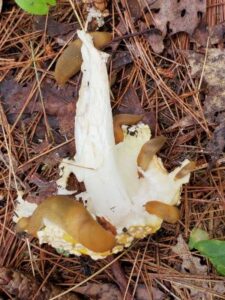July 27: What’s the Deal With All the Slugs?

Tawny Garden Slug
A friend relatively new to the area recently asked me “what’s the deal with all the slugs”? She had noticed that we have a large number of them on our peninsula when compared to her old home. I remember noticing the same thing when I first came to the region, and when you look at our humid climate and damp vegetation, it all makes sense. Our foggy mornings and frequent rain showers provide the ideal environment for an animal that needs to stay moist to stay alive. Throughout the United States, slugs are seen in high numbers in our coastal regions, and anyone who has spent any time in the Pacific Northwest will tell you that our slugs are minuscule compared to their gigantic banana slugs.
When I first researched the slugs of Maine, most of the information I found was all about how to get rid of them. While I view them with fascination on the preserves, it appears that a lot of gardeners view them with disgust and have devised several ways to keep them out of their yards. Slugs are attracted to gardens because they are shady and moist and provide an all you can eat buffet of tender vegetation. This is why most of the slugs in our region have the word “garden’ in their title, despite the fact that they are seen in the woods as well. The brightly colored tawny garden slug is the most common species I see while walking down the trail.

Slugs eating a mushroom
If you want to find some slugs on the preserves (and who wouldn’t?), avoid the sunny hot days and wait for the fog to roll in or go out in the morning after an overnight rainstorm. Slugs come out on the trails to clean up decaying vegetation and they are also big fans of mushrooms. If you don’t see the slugs themselves, it is relatively easy to find signs of them. Mushrooms with munched edges and dime sized holes are often the product of feeding slugs. Glistening trails of clear slime on mushrooms, decaying plants, or even spider webs are usually the result of a slug moving through the area.
While similar to snails, slugs lack a shell and have a prominent mantle instead. They are legless and boneless creatures that belong to the mollusk category, classified as gastropods, where “gastro” means stomach and “pod” means foot. Stomach foot seems like the perfect name for a creature with a large appetite that slides around on a muscular base. Slugs have two upper tentacles that stick out from their foreheads that they use for sight and smell. If you look closely at the upper tentacles, you can see they carry their eyes on the tips. You might also notice the shorter lower tentacles that they use for touch and taste.

Slug trail on spider web
Slugs are hermaphroditic and have both types of reproductive organs, so all they have to do is find another slug to mate. After mating they lay around 50 eggs in damp protected soil. In Maine our slugs usually overwinter as eggs, but adults can survive the snowy season if they find a place that is insulated and sheltered. I often spend time admiring the large slugs I see in early spring, as chances are they have survived a Maine winter. If our region has a mild winter, we will notice an especially large population of slugs that summer. So to all of my fellow slug lovers out there, here’s hoping for balmy weather!




